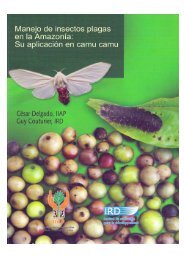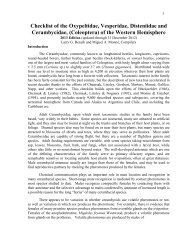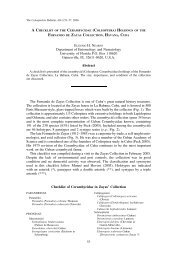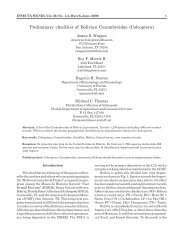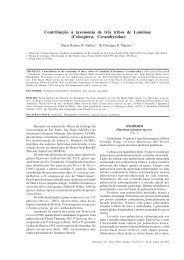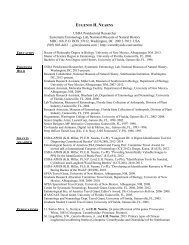Create successful ePaper yourself
Turn your PDF publications into a flip-book with our unique Google optimized e-Paper software.
50 THE TRIBE ONCIDERINI<br />
TULCUS Dillon and Dillon, gen, nov"<br />
Most closely related to H. robusta, but differs from it as fol<br />
lows : head with front less constricted between eyes ; eye with lower<br />
lobe more oblong ; pronotum less conical in outline; elytra on base<br />
simply punctate, basal gibbosities broad, feebly elevated, humeri<br />
obtusely tubercled ; antennae with third and fourth segments more<br />
robust ; femora more strongly clavate, metatibiae more strongly<br />
dilated apically ; and procoxae distinctly uncate in male.<br />
Moderate sized, elongate-ovate, robust, convex. Head with front elongate,<br />
sides oblique, gradually narrowed above, not constricted between eyes; gena vertical ;<br />
eye with lower lobe broadly oblong-ovate, one and one-haif times height of gena ;<br />
antennal tubercles prominent, well separated, with a short, robust tooth at apex<br />
in male. Pronotum transverse, sides broadly arcuate, unarmed, apex distinctly<br />
narrower than base; disk broadly tumid each side, at middle with a. tubercle.<br />
Scutellum transverse. Elytm expanding very slightly before middle, thence nrcuatdy<br />
narrowed to apices, which afe separately rounded; disk on basal half with<br />
sparse, moderate-sized, simple punetUfes, basal gibbosities broad, feebly elevated;<br />
humeri prominent, with an obtuse, slightly elevated tubercle at angle followed by<br />
a very short carina on basal fifth. Prosternum simple, slightly widened behind<br />
middle ; mesosternal process broad, deeply, bilobedly emarginate. Legs moderate<br />
in length ; procoxae globose, strongly uncate in male; femora robust, gradually<br />
clavate from basal third; metatibiae strong dilated apically in male. Antennae<br />
one-third longer than body in male; scape robust, reaching nearly to middle of<br />
pronotum, strongly clavate on apical third; third segment bisinuate, slightly longer<br />
than scape; rest gradually shorter (eleventh segment wanting).<br />
G.KNO'L'YPE.-Hypsioma amazonica Thomson.<br />
Tulcus amazonica Thomson<br />
PLATE IX, FIGURE 13.<br />
Hypsioma am4zomca Thomson, Class. Ceramb., 1860, p. 119. Bates, Ann. Mag.<br />
Nat. Hist., (3), XVI, 1865, p. III (sep. p. 178).<br />
MALE. Elongate-ovate, robust, subcylindrical; head and pronotum piceous or<br />
black; clytm dark reddish-brown. Head and pronotum grayish-fulvous pubescent,<br />
a short, oblique, yellowish-white vitro on gena below lower lobe of eye; pronotum<br />
basally with irregular, dull ochraceous patches. Scutellum medially broadly brown,<br />
sides narrowly fulvous. Elytra brownish-fulvous, mottled very irregularly and indistinctly<br />
with grayish-fulvous, and with a narrow, oblique, very indistinct vitta<br />
from just behind humeri to behind middle at suture, of same color. Beneath dark<br />
reddish-brown, sterna fulvous-gray pubescent; abdomen very finely dark brown<br />
pubescent, laterally broadly fulvous pubescent except on first sternite, which has<br />
only a very small maeula laterally on apical margin. L-egs piceous or dark roodishbrown,<br />
dark brown pubescent, variegated with fulvous and gray pubescence; femora<br />
with a narrow, fulvous fascia at apex; tarsi and tarsal claw segmcnt fulvous-gray



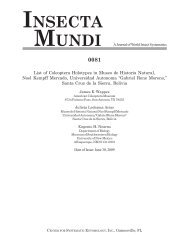
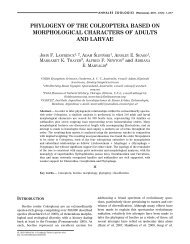


![Coleoptera. Vol. I. [Longicornia. Part I.]](https://img.yumpu.com/41202793/1/180x260/coleoptera-vol-i-longicornia-part-i.jpg?quality=85)
